It Finally Happened: Brand Advertisers Now Represent The Majority Of Podcast Ad Spend; Four Major Implications For Targeting, Creative, Brand Safety, And Measurement
Click here to view or download the full IAB report.
Click here to view or download a PDF of the slides.
Click here to view a 14-minute video of the key findings.
The IAB just released its eighth annual podcast revenue report in partnership with PwC. Brand spending is way up and now represents 61% of all podcast spend, surpassing direct response (39%). This is a historic first.
Podcast advertising revenue was born thanks to direct response advertising. In 2016 and 2017, direct response represented the vast majority of podcast advertising. From 2018 to 2021, the proportion of podcast ad spend was equally split between brand and direct response.
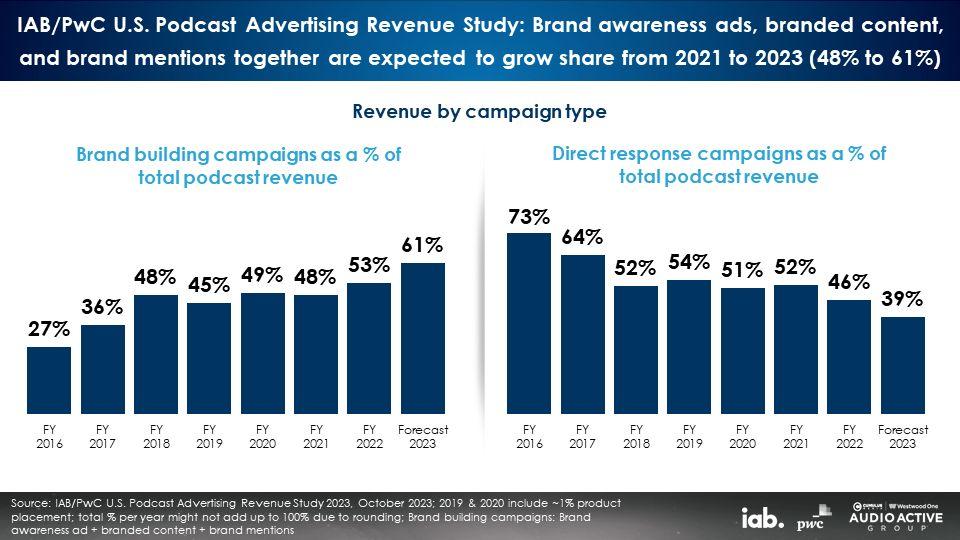
In 2022, brand spending slightly outpaced direct response 53% to 46%. Now in 2023, brand investment surpasses direct response 61% to 39%. The emergence of brand building as the majority of podcast spend is the big “head snapper” from IAB’s 2023 podcast revenue study.
The emergence of brand marketers as the largest podcast revenue segment requires an evolution in targeting, creative, brand safety, and measurement.
Four major implications of the shift to podcast brand advertising
- Targeting will become much broader: Wide campaign reach will become the priority with a goal of “being known before you’re needed.”
- Creative will shift to become more entertaining and emotion based: The objective will be to stir passions and create positive feelings and associations with ads that people find interesting and enjoyable.
- Brand safety and suitability measurement will become more crucial: Firms like Barometer will become powerful resources to help marketers find the right context for their campaigns with nuanced data.
- Measurement will focus on how well campaigns build memories to ensure brands are “easy to mind and easy to find”: Key performance indicators are brand awareness, brand consideration, and brand preference.
The media and creative approaches that power brand building and direct response are very, very different. No longer will podcast advertising exclusively feature tight targeting with dry, rational copy measured by attribution. There will be a shift to broad targeting, emotion-based and entertaining creative, brand safe contexts, and brand lift measurement.
What are the two most important jobs of an advertiser?
A new book and a major study answer these questions and offer key strategies to “convert existing demand” and “create future demand.”
James Hurman is a globally recognized expert on brand building and marketing effectiveness, having spent much of his career researching, publishing, practicing, and teaching marketing effectiveness. Hurman has published the Kindle book, Future Demand: Why Building Your Brand Among Tomorrow’s Customers is the Key to Start-Up Success. You can order your copy here.
Hurman and the World Advertising Research Center have also partnered on a major study, Rethinking Brand for the Rise of Digital Commerce. WARC is the major global organization that devotes itself to the study of marketing effectiveness.
The two most important jobs of an advertiser: Converting existing demand with direct response strategies and creating future demand by brand building
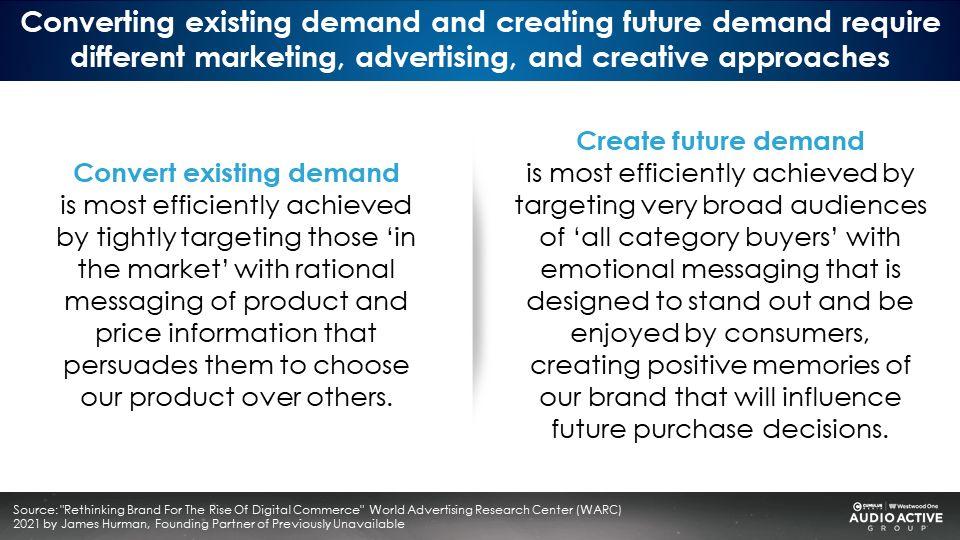
According to Hurman and the WARC, here are the key aspects of the two very different strategies:
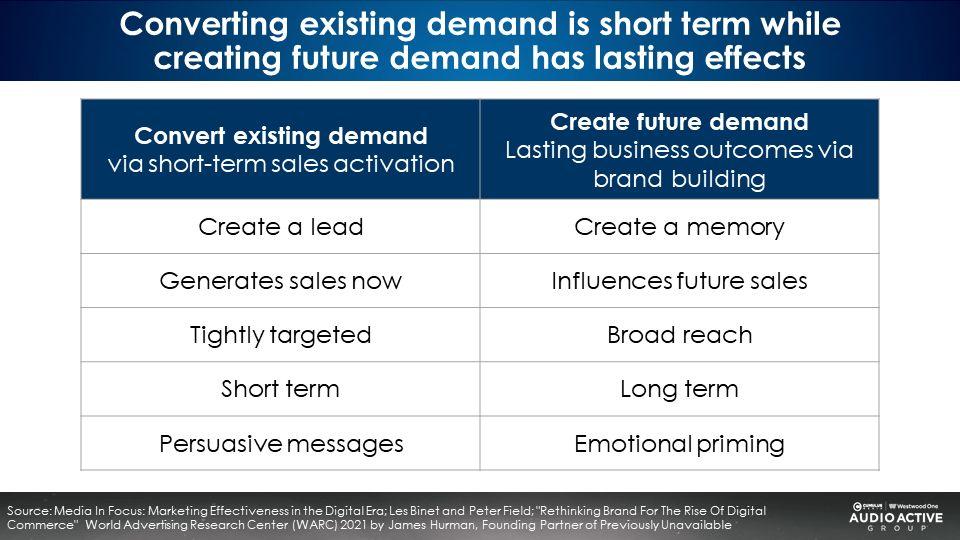
Direct response or promotional copy does not work as well on the large group of consumers who are not in the market and not ready to buy now. Creating future demand is about creating positive memories.
Les Binet: “Emotion is the most powerful selling tool we have”
Binet, one of the “godfathers of marketing effectiveness” has published some of the most read, most utilized, evidence-based studies on how advertising works. Along with Peter Field, Les Binet’s research finds that sales and profit growth are generated by emotion-based ads that “create positive feelings and associations” that are “interesting and enjoyable.”
Binet explains, “The process of building a brand, which is ultimately about preparing someone to buy your product at some point in the future, takes a very long time. When somebody buys a car, that process of making the decision starts maybe 10 or 20 years before they actually come to buy it. Even the process of selecting a chocolate bar, as I did earlier on, that decision has been brewing in my mind ever since I was in school. In order to really build strong brands, you’ve got to start preparing consumers long before they even start thinking about the product or the purchase. That means engaging them when they’re not interested in what you have to say, when they are not thinking about the product, when they have no need to be satisfied. So you can only do that by engaging them with things that are intrinsically interesting at a human level and that will be remembered for a very long time. So emotion is the most powerful selling tool we have. And therefore, emotional media are much more powerful for building brands and generating profit.”
Converting existing demand has short-term impact but little long-term benefit: Direct response and promotions are the carbohydrates of advertising
Les Binet and Peter Field, the “godfathers of marketing effectiveness,” describe the sales effect of promotional strategies that convert existing demand. Sales event advertising creates sharp short-term sales uplifts followed by quick drop offs.
Direct response/promotional sales events generate sales “sugar highs” followed by quick crashes. The grey line below represents the sales effect of converting existing demand via brand building.
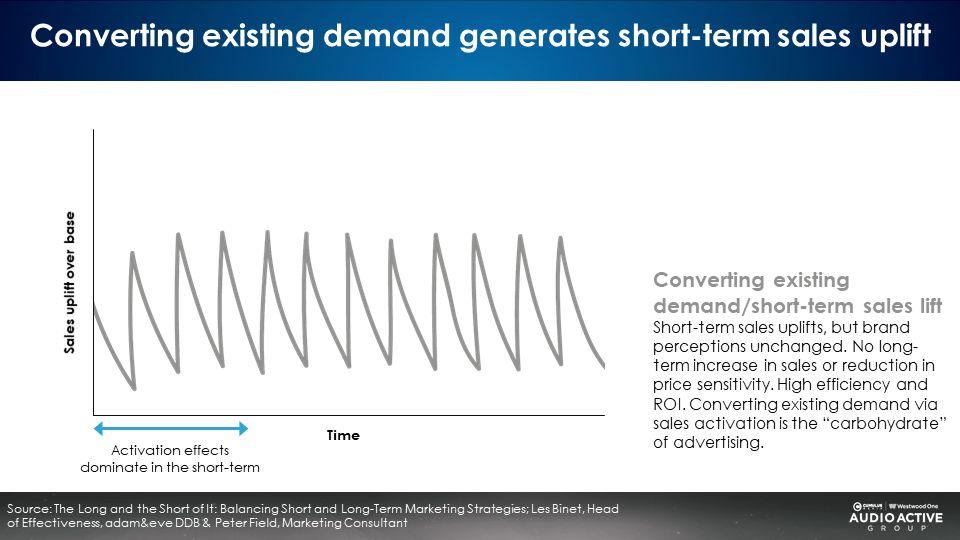
Creating future demand by brand building creates sustained long-term sales and profit growth
The blue line below represents the sales effect of creating future demand with brand building advertising.
Binet and Field recommend marketers allocate 40% of their marketing budgets to converting existing demand via direct response or sales events. They recommend 60% of marketing budgets be devoted to creating future demand via brand building advertising.
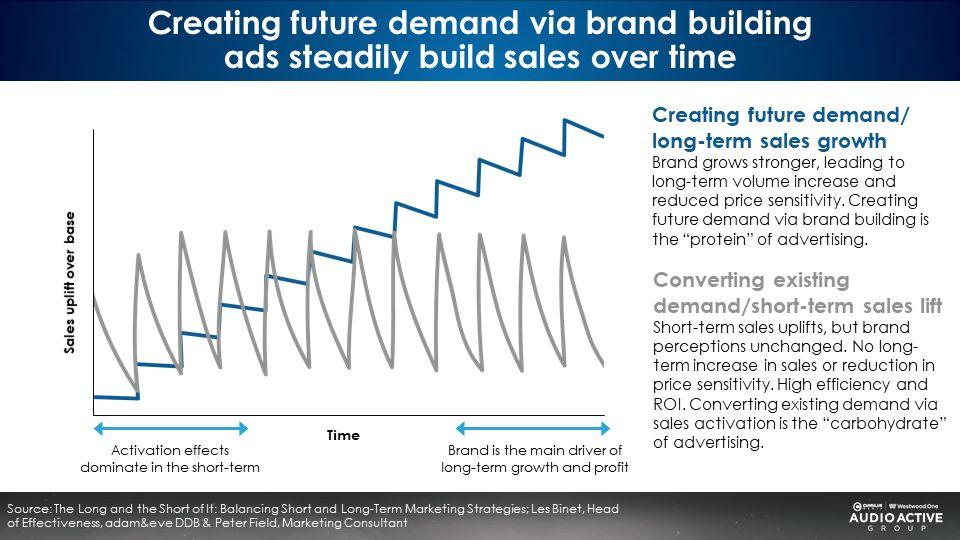
Creating future demand by brand building is the protein of advertising
As a business becomes better known, its brand grows stronger, leading to long-term volume increases and reduced price sensitivity. Creating future demand via brand building is the “protein” of advertising.
Measurement: Converting existing demand with direct response and creating future demand with brand building
The measurement of converting existing demand campaigns examines short-term metrics: clicks, conversions, purchase, and cost per acquisition. Measuring the creation of future demand is focused on measuring brand equity: awareness, consideration, and preference.
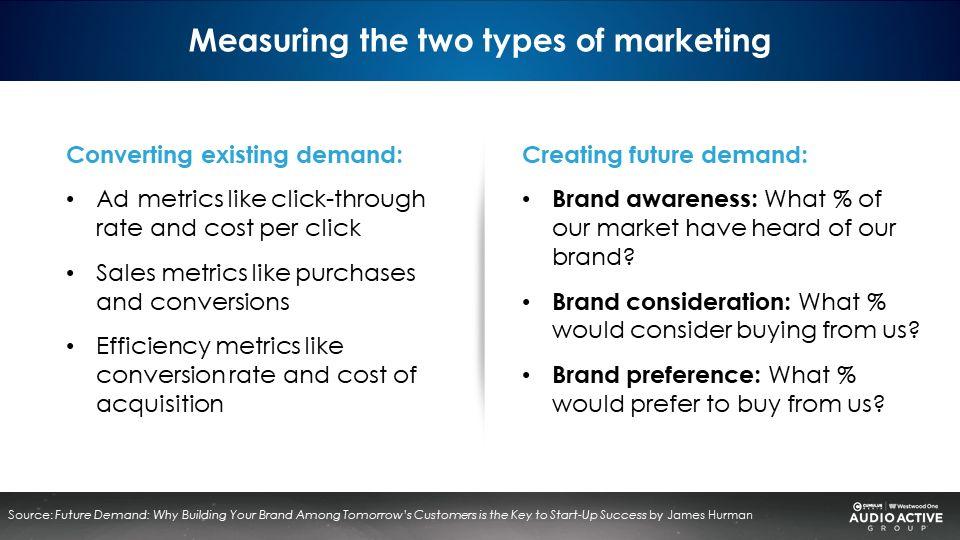
Creative opportunity: Podcast listeners prefer funny and entertaining ads but say they currently hear more ads that communicate dry features/benefits
In Spring of this year, the Cumulus Media | Westwood One Audio Active Group® released the tenth edition of the Podcast Download series. Cumulus Media and Signal Hill Insights retained MARU/Matchbox to conduct an in-depth study of 608 weekly podcast consumers.
The study revealed there is a creative opportunity for advertisers to create funny and entertaining podcast ads. The top two types of podcast ads weekly podcast listeners are interested in are funny ads (74%) and entertaining ads (73%).
However, the top type of podcast ads weekly podcast listeners say they actually hear are ads that communicate features/benefits of products/services (80%). Entertaining and funny podcast ads are only heard by 76% and 71% of weekly podcast listeners, respectively.
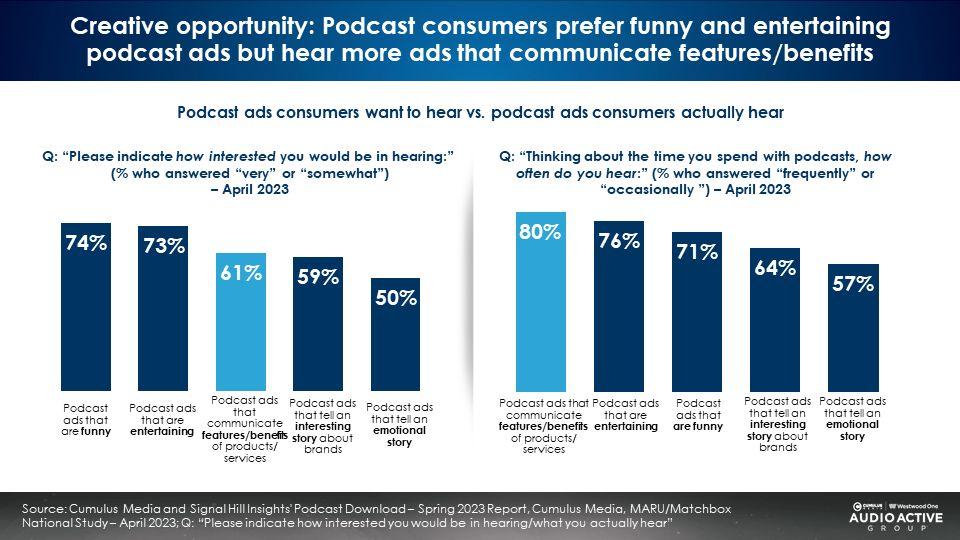
Orlando Wood, System1, one of the leading creative testing companies: “Entertain for commercial gain”
In his book, Why Does The Pedlar Sing? What Creativity Really Means In Advertising, Paul Feldwick urged marketers, “”I would like to encourage all those who work in advertising and brand management to suspend their “delicate feelings” about what really creates popularity and fame, and to embrace the idea that advertising is at least as much showmanship as it is salesmanship. It is time to rediscover the fact that advertising builds brands best when it is entertaining, popular, and memorable, when it is not just a pitch, but a performance.”
Nielsen: Podcast brand effect is measurable and significant
Nielsen has conducted 995 podcast brand lift studies over the past several years. The average lift in brand equity between those exposed and not exposed to podcast ad campaigns is as follows:
- Awareness increases by 12 points
- Likelihood to seek information is up by 8 points
- Purchase intent grows by 6 points
- Brand recommendation improves by 6 points
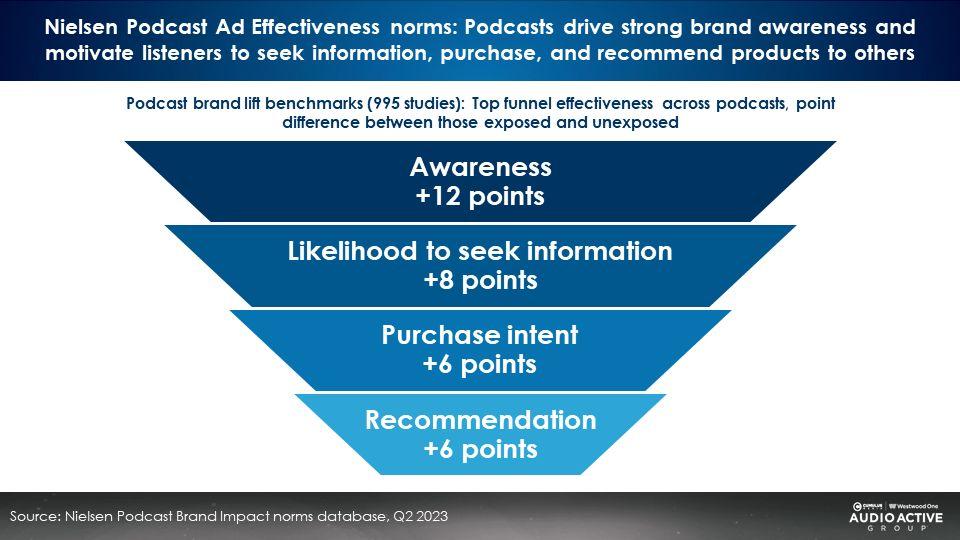
Across a wide variety of product categories, Nielsen reports consistent podcast brand effect lift.
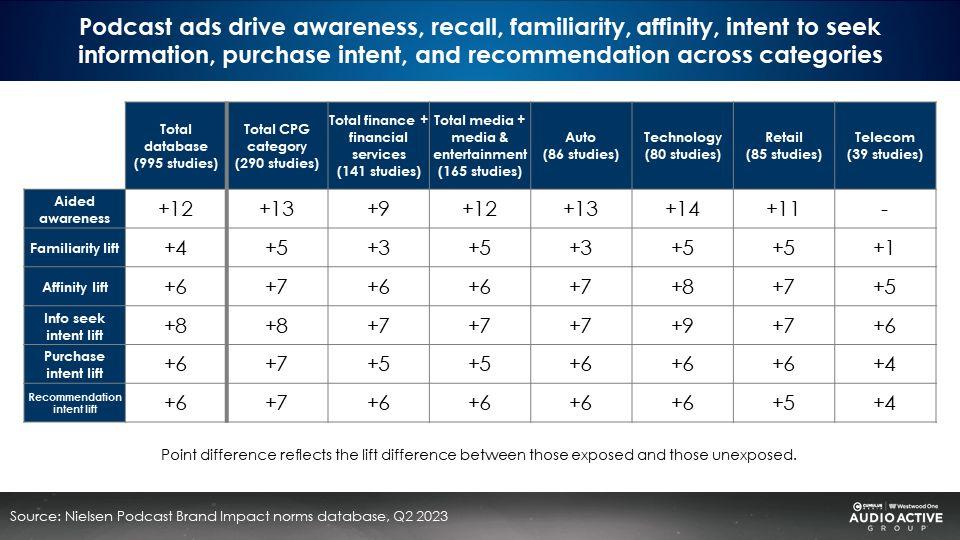
Creating future demand by brand building creates memories and memories generate sales; Clicks don’t generate sales
Jon Lombardo, Global Head of Research at LinkedIn’s B2B Institute, reports, “One of the primary things people misunderstand is how advertising works. People think they just put an ad in front of you and you immediately buy. That’s not how it works. Generally, you don’t generate any sale from an ad, what you do is generate a memory and then at some point later they consult their memory.”
Lombardo explains, “It’s your memory that got you to Google in the first place and your memory is going to pull strong brands. Strong brands are not built on clicks, but on memories. The other thing that’s very interesting is even when people go to Google and click for something, buyers show a bias for the brands they already know.
Lombardo concludes, “It explains what’s really important in marketing is not bottom of funnel, lead generation clicks. It’s top of funnel, brand building memory. That’s the fundamental idea.”
To recap:
Four major implications of the shift to podcast brand advertising
- Targeting will become much broader: Wide campaign reach will become the priority with a goal of “being known before you’re needed.”
- Creative will shift to become more entertaining and emotion based: The objective will be to stir passions and create positive feelings and associations with ads that people find interesting and enjoyable.
- Brand safety and suitability measurement will become more crucial: Firms like Barometer will become powerful resources to help marketers find the right context for their campaigns with nuanced data.
- Measurement will focus on how well campaigns build memories to ensure brands are “easy to mind and easy to find”: Key performance indicators are brand awareness, brand consideration, and brand preference.
Click here to view or download the full IAB report.
Click here to view a 14-minute video of the key findings.
Pierre Bouvard is Chief Insights Officer of the Cumulus Media | Westwood One Audio Active Group®.
Contact the Insights team at CorpMarketing@westwoodone.com.